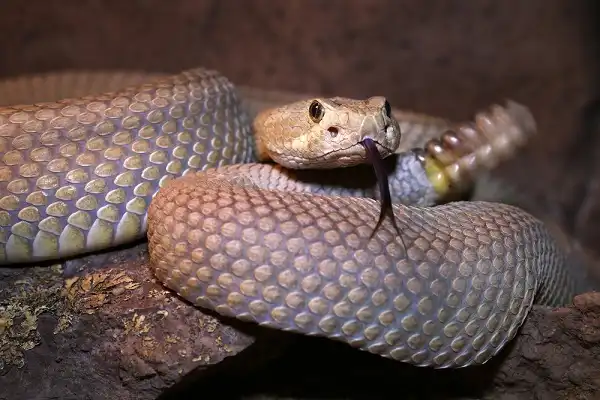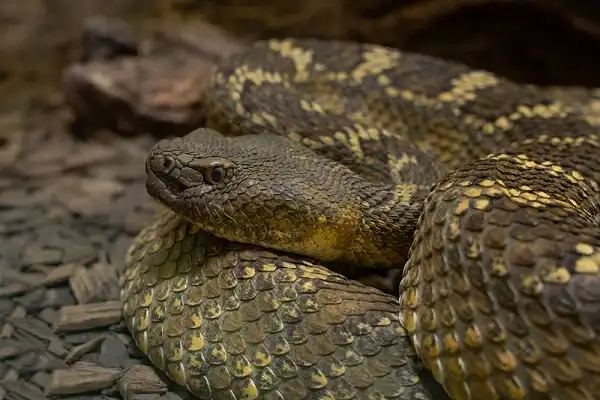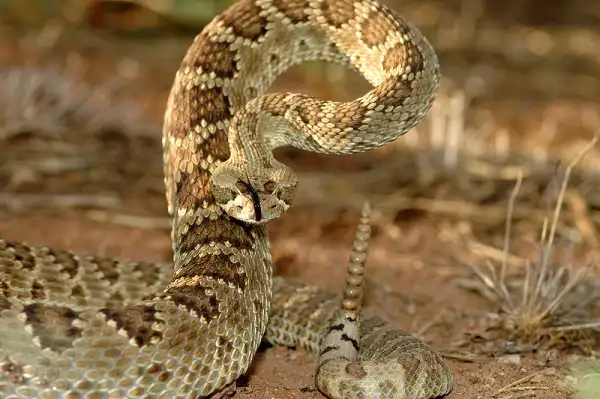If you’ve ever been out in the desert, then you know that rattlesnakes can be a dangerous and unwelcome guest. The Mojave rattlesnake is especially notorious, known for its quick strikes and powerful venom. This slithering species has many features that allude to its impressive toxicity – from its triangular head to the markings spanning along its back. In this blog post, we will be taking an in-depth look at everything from the Mojave Rattlesnake’s physical characteristics to their behavior patterns and even how best to protect yourself if one should cross your path. Read on for further information about this fascinating species!

Mojave Rattlesnake Description
The Mojave rattlesnake is a venomous reptile native to the Southwestern United States and northern Mexico. It is named after the Mojave Desert, which is one of the areas it inhabits. The rattlesnake has a distinctive triangular head, which is wider than its neck, giving it a distinct “diamond” shape. Its skin color can range from light gray to brown, with darker diamonds along the length of its back. The venom of the Mojave rattlesnake is highly toxic, containing venomous neurotoxins and hemotoxins that can cause paralysis, internal bleeding, and tissue damage.
Mojave Rattlesnake Habitat
The Mojave rattlesnake thrives in a variety of desert habitats, including rocky outcroppings, sandy washes, and arid grasslands. They can be found throughout the Mojave and Sonoran Deserts in the southwestern United States, as well as in parts of northern Mexico. While these snakes prefer hot, dry areas with plenty of cover for hiding and ambush hunting, they are adaptable creatures and can also be found in more rugged terrain or areas with sparse vegetation. Some populations have even been observed at altitudes above 9,000 feet (2,700 meters) in mountainous regions. Interestingly, these snakes are able to regulate their body temperature by moving between areas with sun exposure and shade. During the hottest times of the day, they will seek refuge in shady areas or underground burrows to avoid overheating. Due to their wide distribution and ability to occupy a variety of habitats, the Mojave rattlesnake has become an important species in its ecosystem. They play a vital role in controlling rodent populations, which can cause damage to crops and ecosystems.
Mojave Rattlesnake Diet
The Mojave rattlesnake, like many other snakes, is a carnivorous species with a diverse diet. While they primarily consume rodents such as mice, rats, and squirrels, they are also known to be opportunistic hunters and will prey on other small mammals such as rabbits, ground-nesting birds, and lizards. Interestingly, the Mojave rattlesnake has been observed exhibiting cannibalistic behavior, where larger individuals will feed on smaller ones. They have also been known to consume their own young, which may serve as a survival strategy during times of food scarcity. The hunting strategy of the Mojave rattlesnake is largely dependent on their ambush tactics. They will often wait for their prey to come within striking distance before delivering a quick bite. The neurotoxic venom found in their venom duo will then work quickly to paralyze the respiratory system of their prey, making it easier to swallow whole.
Mojave Rattlesnake Size
The Mojave rattlesnake is one of the largest venomous snakes in North America, with the average adult size ranging from 3 to 4 feet in length. However, some individuals can grow up to 6 feet long. They have a powerfully built body, with a triangular head and distinctive rattles at the end of their tails. The body of the Mojave rattlesnake is covered in scales that provide protection and aid in movement across rough terrain. The scales on their belly are smooth, allowing for efficient movement on the ground. The scales on their back are keeled, providing a rough texture that aids in climbing over rocks and other obstacles.

Mojave Rattlesnake Lifespan
The lifespan of the Mojave rattlesnake is a topic of much debate amongst researchers and experts. While there is no consensus on the exact lifespan of this species, studies have shown that they can live for several decades in the wild. Factors such as climate, habitat, and available prey can all influence the lifespan of these snakes. Generally, individuals living in warmer and more arid regions tend to have shorter lifespans than those living in cooler, more temperate climates. This is due to the increased stress on their bodies caused by high temperatures and extended periods of drought. In addition to environmental factors, the size and sex of the snake can also play a role in determining their lifespan. Larger individuals tend to live longer than smaller ones, and female snakes may live longer than males due to their reduced risk of predation. While there is no definitive answer to how long the Mojave rattlesnake can live, some research suggests that they may be capable of living up to 20 years or more in the wild. However, this is dependent on a variety of factors and may not always be the case.
Mojave Rattlesnake Behavior
Mojave rattlesnakes are fascinating creatures with unique behaviors that are essential to their survival in the harsh desert environment they call home. These snakes are solitary and primarily active at night, using their powerful sense of smell and heat-sensitive pits to locate prey and avoid predators. When threatened, the Mojave rattlesnake will often rattle its tail as a warning to potential predators. This rattle is made by vibrating special segments at the end of the tail and serves as a clear signal to other animals that the snake is dangerous and should be avoided. In addition to their warning rattle, Mojave rattlesnakes also have a variety of other physical and behavioral adaptations that protect them from predators. For example, their coloration and pattern help them blend in with their surroundings, making them difficult to spot by predators such as birds and mammals. They also have a unique venom that is highly toxic and specifically designed to immobilize their prey and deter predators from attacking.
Mojave Rattlesnake Speed
Mojave rattlesnakes are remarkable creatures that inhabit the arid regions of the southwestern United States and northern Mexico. In addition to their unique behaviors and impressive lifespans, these snakes are also known for their incredible speed. While it is difficult to measure the speed of a Mojave rattlesnake in the wild, studies have shown that they are capable of moving at incredibly fast speeds when necessary. Using their powerful muscular bodies, these snakes can travel across the desert at speeds of up to 10 miles per hour, making them one of the fastest snakes in the world. Despite their impressive speed and other adaptations, however, Mojave rattlesnakes still face many threats in the wild. Habitat loss and fragmentation, as well as climate change, are all major challenges that put this important species at risk. By understanding and addressing these challenges, we can help to ensure the continued survival and success of this remarkable creature and the ecosystems that rely on them.

Mojave Rattlesnake Hunting
Mojave rattlesnakes are skilled hunters that have adapted over time to master their unique desert environment. They use their impressive speed, powerful muscles, and a range of specialized sensory mechanisms to capture prey. Their hunting technique is strategic and efficient. Using their heat-sensing mechanism, they locate potential prey, which includes small mammals, rodents, birds, and lizards. The venom in their fangs allows for quick immobilization of their prey, ensuring that the Mojave rattlesnake can consume it without interruption. During hunting, the Mojave rattlesnake uses its unique physical features to achieve success. Its patterned skin provides camouflage, allowing it to blend in with the surrounding environment and remain hidden from predators. Their muscular bodies are capable of swift movement, even over uneven terrain, which allows them to pursue prey with agility. Mojave rattlesnakes are also masters of deception. They use a variety of behavioral tactics, from remaining completely still to tricking their prey into believing that they are a harmless object like a rock, to ambush and capture unsuspecting prey.
Mojave Rattlesnake Venom and Dangerousness
Mojave rattlesnakes are one of the most venomous snakes in North America, and their bite can be fatal if left untreated. The venom is composed of various neurotoxins, hemotoxins, and mycotoxins that cause severe damage to tissue and organs. When threatened or provoked, Mojave rattlesnakes will shake their tail and emit a loud buzzing sound as a warning sign. If ignored, they will strike with lightning speed and inject their venom into the target. This can result in immediate swelling at the site of the bite and potentially life-threatening symptoms such as nausea, dizziness, difficulty breathing, paralysis, kidney failure, and even death. Despite their dangerousness when provoked, Mojave rattlesnakes are not aggressive and tend to avoid humans when given the chance. It is important to be aware of their presence in the desert and use caution when interacting with them or any other wild animal.
Mojave Rattlesnake Reproduction
Mojave rattlesnakes reproduce using both sexual and asexual reproduction. During the breeding season, males will follow females to find a mate, and then engage in physical combat with other males for dominance. After mating has occurred, the female will lay between 2 to 10 eggs which can take up to 5 months to hatch. The young Mojave rattlesnakes are born with their fangs already developed, allowing them to hunt right away. They quickly grow into adulthood and reach maturity at around 3 years of age.

Conclusion
The Mojave rattlesnake is an impressive creature with remarkable adaptations, such as their speed, camouflage, and powerful venom. They use these features to hunt in a variety of ways and are essential predators in their ecosystem. However, they face numerous threats from humans and climate change that put them at risk. It is important to understand the importance of this species and take proactive steps to ensure their continued survival. By doing so, we can help maintain the balance of their unique desert environment for generations to come.
Frequently Asked Question


